33 Blue Flowering Shrubs (with Pictures): Identification Guide
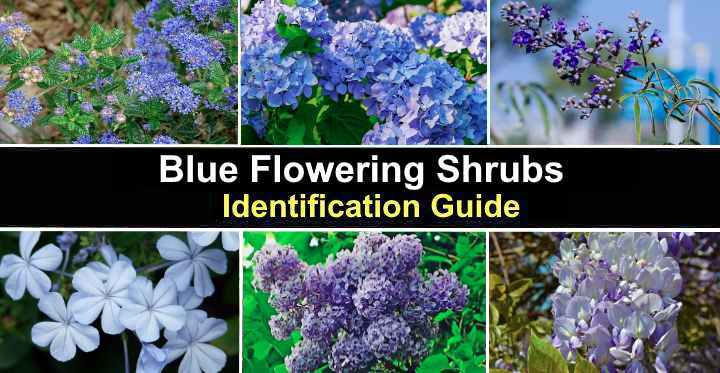
Blue-flowering shrubs add a touch of elegance and serenity to any garden landscape. Shrubs with vibrant blue, teal, indigo, and aqua blue blossoms can create a stunning focal point. The unique blue flowers complement the shrubs’ deep green, lush foliage, and other plants and flower gardens. From the delicate blue hydrangea to the striking bluebeard and the beautiful blue butterfly bush, there are many types of blue-flowering shrubs to choose from.
Blue flowers are rare in nature because plants lack blue pigments. The blue color in flowers comes from a combination of pigments, ions, and molecules. Some ornamental shrubs like hydrangeas have blue flowers due to the soil’s acidity. Therefore, blue-flowering shrubs create unique visual interest and diversity in a garden landscape.
This article is a comprehensive identification guide to blue-flowering shrubs. Descriptions and pictures of various shrubs with blue blooms will help you select the perfect addition to your garden.
What Are Blue Flowering Shrubs?
Blue-flowering shrubs are woody multi-stemmed ornamental bushy plants with blue-colored blossoms. The most common shrubs with blue flowers are hydrangeas, lilacs, hibiscus, and butterfly bushes. Blue-blooming shrubs typically grow between 1 and 10 ft. (0.3 – 3 m) tall. Their vibrant blue hues contrast nicely with greenery, enhancing your yard’s aesthetic appeal.
How to Identify Blue Flowering Shrubs
Identifying blue-flowering shrubs for your front or backyard involves examining the leaf shape, size, and arrangement. Also, consider the shrub’s growth, like mature height and width. Most shrubs are identifiable by their flower shape and form. Some shrubs have blue flowers with showy double blooms, whereas others have conical clusters of blue blossoms.
Blue Flowering Shrubs – Descriptions with Pictures
Whether you’re looking for a pop of color in your garden or want to create a serene and calming atmosphere, this guide will help you choose the best blue flowering shrubs for your landscape.
Blue-Flowering Mophead Hydrangea (Hydrangea macrophylla)
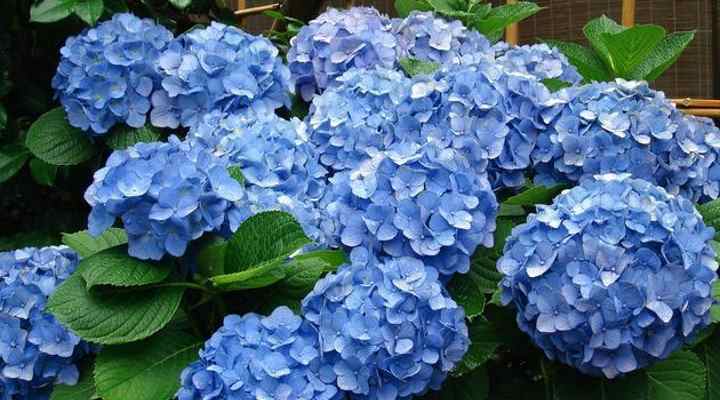
Hydrangeas are one of the most popular blue-flowering shrubs for planting in partial shade. Mophead hydrangeas are identified by their huge, rounded flowerheads. These are densely packed with deep blue star-shaped florets. The blue flower clusters contrast with large, lustrous, serrated leaves. Mophead hydrangeas grow 3 to 6 ft. (1 – 1.8 m) tall and wide.
Related reading: How to care for hydrangea shrubs.
The most spectacular blue-flowering mophead or bigleaf hydrangea cultivars are the ‘Nikko Blue’ and ‘Mariesii Licacina.’
Hydrangea macrophylla ‘Nikko Blue’
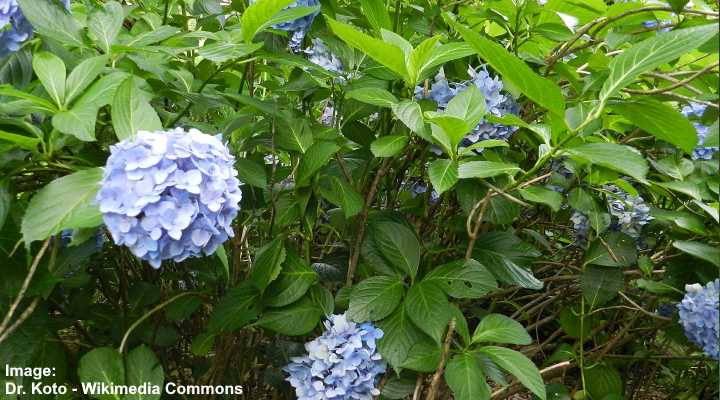
Hydrangea macrophylla ‘Nikko Blue’
Bigleaf hydrangea ‘Nikko Blue’ is a popular hydrangea cultivar known for its large, vibrant blue flowers. This deciduous shrub grows 4 to 6 feet (1.2 – 1.8 m) tall and wide. Its large blue flowering clusters measure 5” (12 cm) across. The hydrangea shrub blooms throughout the summer until fall in partial shade.
To ensure blue flowers on your shrub, it’s vital to plant ‘Nikko Blue’ hydrangeas in acidic soil. You can plant the beautiful shrub as a foundation planting, accent plant, hedge, or container planting.
- Mature Size: 4 to 6 ft. (1.2 – 1.8 m) tall and wide
- USDA Hardiness Zones: 6 to 9
- Light: Partial shade
- Soil: Acidic, organically rich, well-drained soils
Hydrangea macrophylla ‘Mariesii Lilacina’
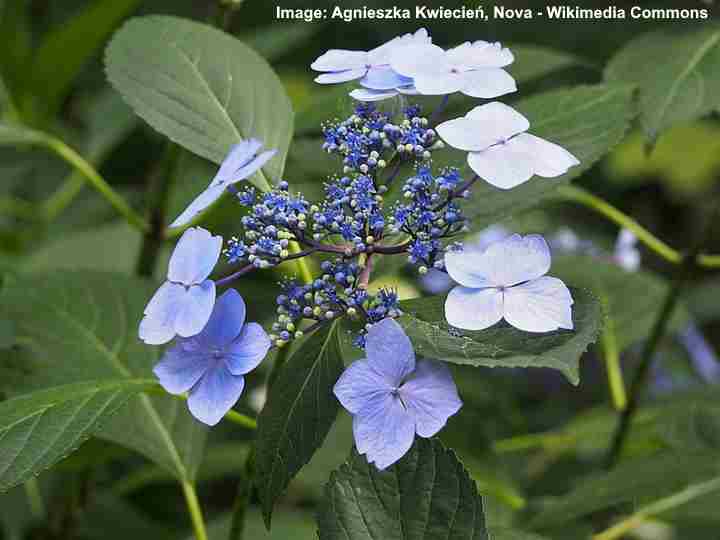
Hydrangea macrophylla ‘Mariesii Lilacina’
Bigleaf hydrangea ‘Mariesii Lilacina’ is a beautiful shrub with masses of mauve to blue lacecap flowers in acidic soil. The long-blooming bushy shrub has bluish-lilac flowerheads 6” to 8” (15 – 20 cm) across. The blue flowers and deep green lanceolate foliage grow on a rounded bush 5 ft. (1.5 m) tall and wide.
Bigleaf hydrangea ‘Mariesii Lilacina’ is a relatively low-maintenance shrub for partial shade or full sun. However, planting in full sun requires keeping the ground consistently moist throughout summer and fall. You can prune the shrub in late winter or early spring to maintain its shape. This hydrangea cultivar is a great choice as a focal point in a flower bed or as a border plant.
- Mature Size: 5 ft. (1.5 m) tall and wide
- USDA Hardiness Zones: 6 to 9
- Light: Full sun to Partial shade
- Soil: Organically rich, acidic, well-drained soils
Blue-Flowering Mountain Hydrangeas (Hydrangea serrata)
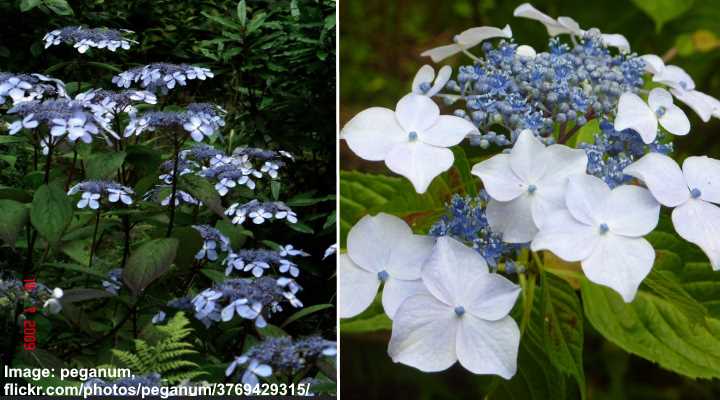
Mountain hydrangea is a group of beautiful deciduous shrubs, some of which have eye-catching pale blue and light pink lacecap flowers. The small blue-flowering shrubs typically grow 3 to 4 ft. (1 – 1.2 m) tall and wide. Like all hydrangeas, the bushy shrubs must grow in acidic soil to produce blue flowers. Otherwise, the flowering shrubs will have pink blooms.
Two blue-flowering mountain hydrangea cultivars are the ‘Blue Billow’ and ‘Bluebird.’
Hydrangea serrata ‘Blue Billow’
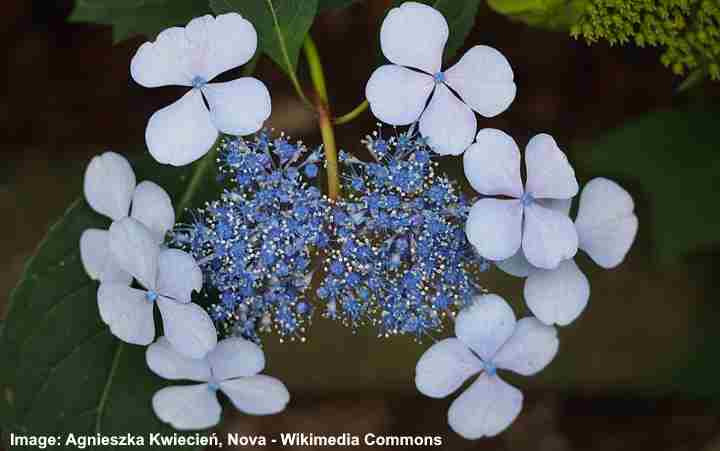
Hydrangea serrata ‘Blue Billow’
The mountain hydrangea ‘Blue Billow’ has stunning large, showy light blue flowers growing in lacecap clusters. Its pale blue flowers grow to 6” (15 cm) across and bloom in mid-summer for several weeks. It has dark green lanceolate leaves that turn an eye-catching burgundy shade in the fall.
‘Blue Billow’ hydrangea is a low-maintenance hardy shrub that requires minimal pruning. The low-growing bushy plant performs well in partial shade as a foundation planting, accent plant, or container planting. It’s a versatile and stunning plant that will enhance any garden or outdoor space.
- Mature Size: 2 to 3 ft. (0.6 – 1 m)
- USDA Hardiness Zones: 5 to 9
- Sun Exposure: Partial shade or dappled sunlight
- Soil Type: Well-drained soil, rich, acidic soil
Hydrangea serrata ‘Bluebird’
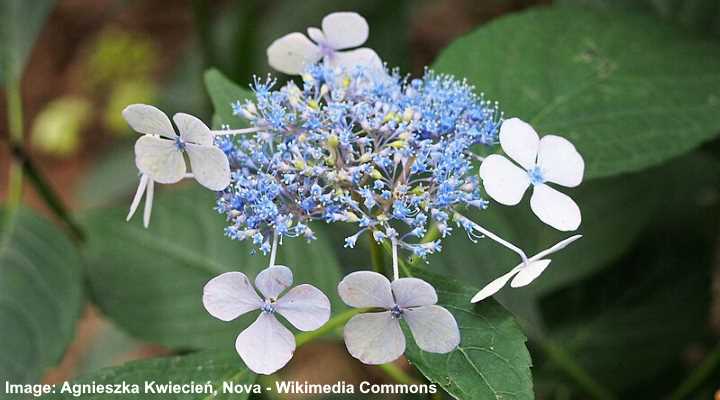
Hydrangea serrata ‘Bluebird’
Hydrangea serrata ‘Bluebird’ is a compact deciduous shrub known for its beautiful blue lacecap flowers. Its rich blue and pale lilac florets contrast nicely with the shrub’s deep green foliage. The blue flowers measure 8” (20 cm) across and cover the small shrub throughout summer through fall. Its fall foliage colors are brilliant red hues.
‘Bluebird’ hydrangea’s dwarf size makes it ideal for small gardens or containers. Its clusters of flat, lacecap flowers look attractive growing in containers, along a foundation line, or as an accent plant for taller shrubs.
- Mature Size: 3 to 4 ft. (1 – 1.2 m) tall and wide
- USDA Hardiness Zones: 6 to 9
- Sun Exposure: Partial shade
- Soil Type: Well-drained acidic soil
California Lilac (Ceanothus)

California lilacs are drought-tolerant, sun-loving shrubs with charming clusters of spectacular blue flowers. Blooming from spring through fall, the blue-flowering shrubs, with their cobalt, azure, and indigo flowers, have lance-shaped, holly-like leaves. The breathtaking blue fragrant flowers cover the shrub, attracting pollinators, bees, and butterflies.
Also called blueblossom or wild lilac, the blue-flowering shrubs thrive in a variety of soil types. They are low-maintenance bushy plants with tremendous aesthetic appeal.
You can grow the shrubs as a focal point in a container garden, along a foundation, or on a shrub border. Its tolerance for salt air makes it an ideal addition to coastal gardens.
Here are two stunning California lilac cultivars suitable for large and small landscapes.
Blue Blossom (Ceanothus thyrsiflorus)
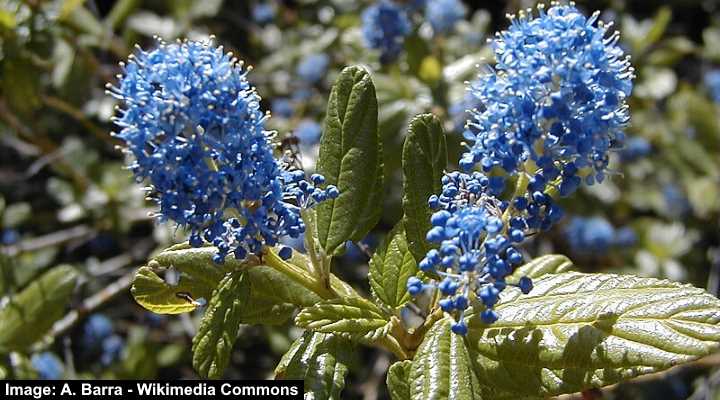
Blue blossom (Ceanothus thyrsiflorus)
Blue blossom is a beautiful evergreen shrub producing clusters of small, fragrant, dark blue flowers covering the plant in the spring. This drought-tolerant, fast-growing shrub has arching branches with lustrous green leaves and blue blossoms. Thriving in full sun, the large shrub grows up to 20 ft. (6 m) tall.
This hardy California wild lilac evergreen shrub is ideal for hedges, wall-side borders, shrub borders, or as a focal point in the garden. The vibrant blue flowers attract pollinators like bees and butterflies. Also, its tolerance to salt spray makes it great for planting in coastal landscapes.
- Mature Size: 15 to 20 ft. (4.5 – 6 m)
- USDA Hardiness Zones: 7 to 11
- Sun Exposure: Full sun or partial shade
- Soil Type: Well-drained soil
Creeping Blue Blossom (Ceanothus thyrsiflorus var. repens)
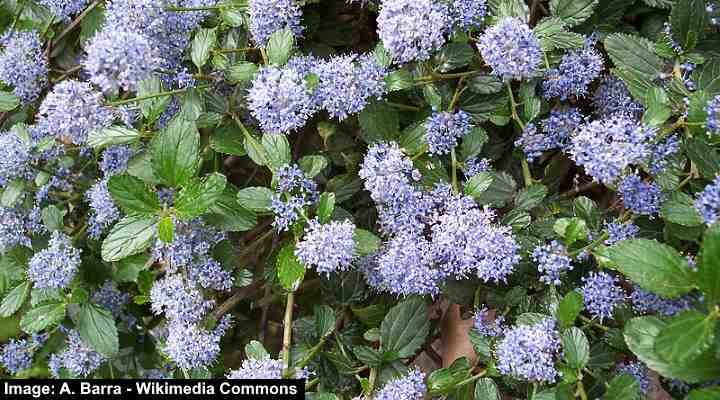
Creeping blue blossom (Ceanothus thyrsiflorus var. repens)
Creeping blue blossom is a low-growing evergreen shrub that produces clusters of vibrant sky-blue fragrant flowers. The creeping shrub thrives in full sun and dry to medium moisture soils. The dwarf shrub grows up to 3 ft. (1 m) tall and 10 ft. (3 m) wide.
Drought-tolerant creeping blue blossom is ideal for blue-flowering ground cover and erosion control. You can also plant the spreading shrub as a foundation planting, wall-side border, or to attract butterflies. It’s also useful for stabilizing the ground on banks and slopes. This versatile shrub is great for adding blue color and texture to your garden.
- Mature Size: 2 to 3 ft. (0.3 – 1 m) tall and 6 to 10 ft. (1.8 – 3 m) wide
- USDA Hardiness Zones: 7 to 11
- Sun Exposure: Full sun or partial shade
- Soil Type: Average soils with dry to medium moisture that drain well
Blue-Flowering Lilac Shrubs (Syringa vulgaris)
Blue-flowering lilac shrubs are famed deciduous bushy plants with conical clusters of lavender blue spring flowers. Other identifying features of lilac shrubs are their luscious, green, heart-shaped leaves, round growth habit, and persistent spring blooming. The shrubs grow 5 to 10 ft. (1.5 – 3 m) tall, depending on the cultivar.
Blue-flowering lilacs perform best planted in full sun to ensure optimal growth and blooming. Here are two outstanding lilac bushes that bloom with clusters of fragrant blue flowers.
Syringa vulgaris ‘Aucubaefolia’
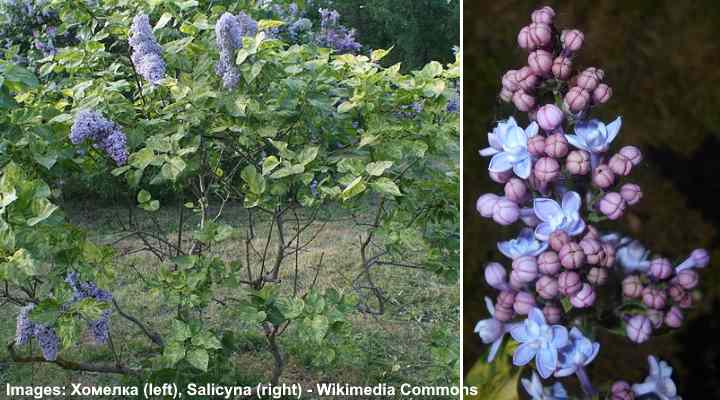
Syringa vulgaris ‘Aucubaefolia’
Syringa vulgaris ‘Aucubaefolia’ blue-flowering lilac shrub is known for its unique green and yellow variegated foliage. The large shrub has heart-shaped variegated leaves and arching conical clusters of fragrant lavender-blue flowers. To add to its showy display, the flowers are semi-double and attract butterflies and bees.
- Mature Size: 8 to 10 ft. (2.4 – 3 m) tall
- USDA Hardiness Zones: 3 to 7
- Sun Exposure: Full sun
- Soil Type: Light, alkaline, moist, well-drained soils
Syringa vulgaris ‘Wonderblue’
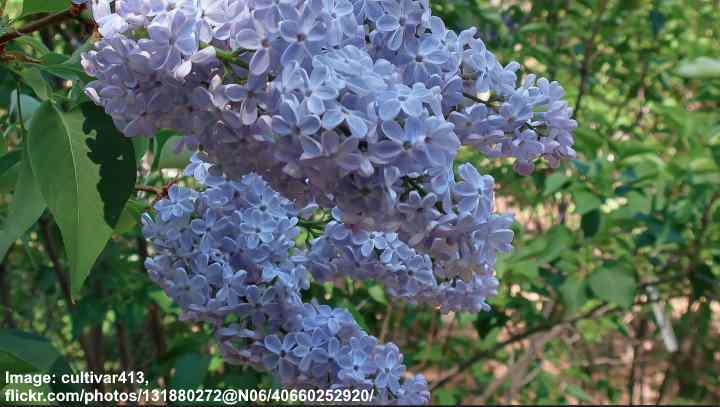
Syringa vulgaris ‘Wonderblue’
Syringa vulgaris ‘Wonderblue’ is a variety of common lilac known for its beautiful sky-blue single flowers. This deciduous shrub has a compact branching habit with heart-shaped leaves, highly fragrant icy lavender-blue blossoms, and dwarf size. This lilac variety is low-maintenance and easy to grow in full sun and well-drained soil.
- Mature Size: 3 to 5 ft. (1 – 1.5 m) tall and wide
- USDA Hardiness Zones: 3 to 7
- Sun Exposure: Full sun
- Soil Type: Light, alkaline, moist, well-drained soils
Chaste Tree (Vitex agnus-castus)
Chaste trees are small to large deciduous shrubs with beautiful spikes of lavender-blue flowers. Blooming in late summer, chaste trees have masses of conical flowering spikes contrasting with their linear, dark green foliage. The fast-growing shrubs bloom with fragrant flowers and attract butterflies and bees.
Typically purple flowering shrubs, some chaste trees have showy flowering spikes with distinctive blue flowers. Here are two popular cultivars— ‘Blue Diddley’ and ‘Abbeville Blue.’
Vitex agnus-castus ‘Blue Diddley’
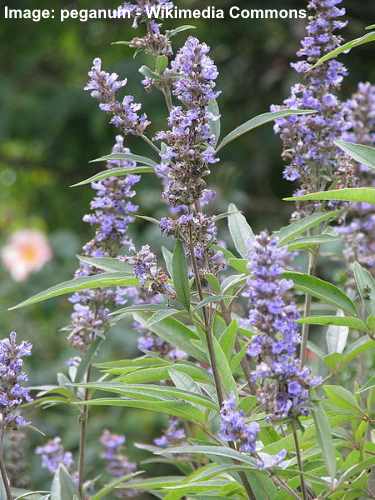
Blue Diddley chaste tree (Vitex Agnus-Castus ‘Blue Diddley’)
The chaste tree cultivar ‘Blue Diddley’ is an attractive dwarf shrub with clusters of bluish-purple tubular flowers. The small shrub grows up to 6 ft. (1.8 m) tall and wide, and its flower spikes measure 10” to 12” (25 – 30 cm) long. It blooms in early summer to early fall.
The fast-growing vitex shrub performs well as a foundation planting, shrub border, or container plant.
- Mature Size: 3 to 6 ft. (1 – 1.8 m)
- USDA Hardiness Zones: 5 to 9
- Sun Exposure: Full sun
- Soil Type: Well-drained loose soil with medium moisture
Vitex agnus-castus ‘Abbeville Blue’
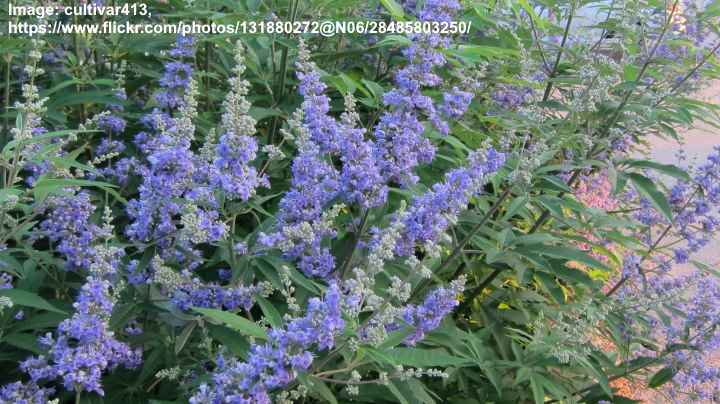
Abbeville Blue chaste tree (Vitex Agnus-Castus ‘Abbeville Blue’)
‘Abbeville Blue’ chaste tree cultivar is a beautiful blue-flowering shrub with purple-blue flowers. This deciduous shrub features silvery-green lance-shaped leaves, dark blue flowering spikes, and a bushy growth habit. The large ornamental shrubs are ideal for adding height and structure to a garden landscape.
Landscaping uses for ‘Abbeville Blue’ chaste trees include a hedge or mixed plantings. It is also deer-resistant, making it a great choice for gardens in areas with deer populations.
- Mature Size: 4 to 10 ft. (1.2 – 3 m)
- USDA Hardiness Zones: 6 to 9
- Sun Exposure: Full sun
- Soil Type: Loose, well-drained average moisture
Bluebeard (Caryopteris x clandonensis)

Bluebeard is a low, mounding shrub with beautiful, attractive blue flowers, creating a fluffy, cloud-like appearance. Blooming in late summer and fall, this deciduous shrub is known for its aromatic foliage, low-maintenance, gray-green leaves, and clusters of blue tubular flowers on long stems.
Bluebeard shrubs grow up to 3 ft. (1 m) tall, making them perfect for landscaping compact front or backyards. You can also plant the small blue-flowering shrub in borders, as hedges, or as focal points in the garden. They attract butterflies and make great cut flowers for indoor arrangements.
- Mature Size: 2 to 3 ft. (0.6 – 0.9 m)
- USDA Hardiness Zones: 6 to 9
- Sun Exposure: Full sun
- Soil Type: Well-drained loamy soil
Blue Chiffon Rose of Sharon (Hibiscus syriacus ‘Blue Chiffon’)
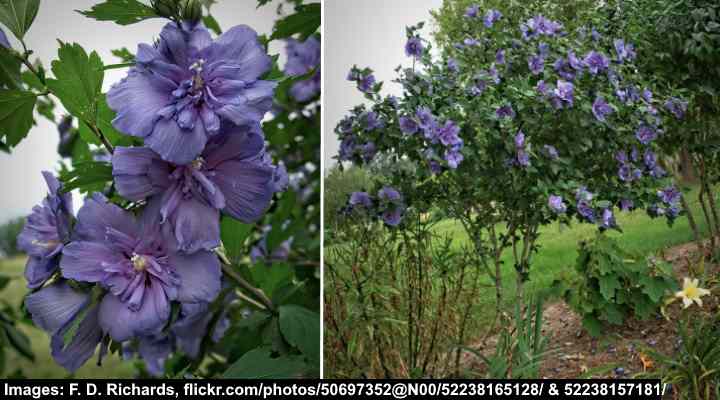
Rose of Sharon ‘Blue Chiffon’ is a stunning blue-flowering shrub with tropical trumpet-shaped pale blue semi-double flowers. The exotic purple-blue flowers measure 4” (10 cm) across. They feature a star-like reddish-purple marking at the base of the ruffled outer petals. The blue flowers appear from mid-summer to early fall, attracting butterflies and hummingbirds.
Also called Hibiscus syriacus ‘Notwoodthree,’ the shrub grows up to 12 ft. (3.6 m) tall. The hardy shrub and its blue flowers tolerate heat, humidity, drought, and salty air. It can also perform well in poor soils. Suitable for USDA zone 5 and above, you can plant the shrub as a hedge, blue-flowering border, privacy screen, or foundation planting.

Blue rose of Sharon can also come as a single bloom variety
- Mature Size: 8 to 12 ft. (2.4 – 3.6 m) tall, 4 to 6 ft. (1.2 – 1.8 m) wide
- USDA Hardiness Zones: 5 to 9
- Sun Exposure: Full sun
- Soil Type: Wide range of soil conditions, but prefers organically rich soils
Russian Sage ‘Blue Spire’ (Perovskia atriplicifolia ‘Blue Spire’)

Russian sage ‘Blue Spire’ is a perennial shrub with spikes of small violet-blue flowers. Blooming throughout summer through fall, the tough flowering subshrub features aromatic gray-green leaves and slender bluish-purple flowering spikes, creating fuzzy clusters. The drought-tolerant shrub grows up to 3 ft. (1 m) tall.
Russian sage is a versatile plant with various landscaping uses in garden settings. Ideal for xeriscaping, the blue-flowering small shrub is ideal for border shrubs, mass plantings, or planting along a fence line. Additionally, Russian sage attracts butterflies and bees to the garden. Its stems also provide visual appeal in winter.
- Mature Size: 2 to 3 ft. (0.6 – 1 m)
- USDA Hardiness Zones: 4 to 9
- Sun Exposure: Full sun
- Soil Type: Dry to medium, well-drained average soils
Sage (Salvia)
Several sage shrubs have attractive, aromatic foliage and blue-flowering spikes that bloom from late spring through fall. There are many different varieties of sage, but they all have aromatic leaves and colorful flowers. Sage plants can vary in size, with some varieties of blue-flowering sage growing as tall as 5 ft. (1.5 m).
Here are a few sage shrubs and subshrubs with blue flowers:
Salvia ‘Blue Chiquita’: This blue shrub has upward-pointing blue flowering spikes measuring 2 ft. (0.6 m) tall and growing in clumps of 3 ft. (1 m) wide. For USDA zones 7 to 9.

Salvia ‘Blue Chiquita’
Pitcher Sage (Salvia azurea): Sky-blue, two-lipped flowers identify this clump-forming shrubby perennial for partial shade. It grows 3 to 5 ft. (1 – 1.5 m) tall and up to 4 ft. (1.2 m) wide. For USDA zones 5 to 9.
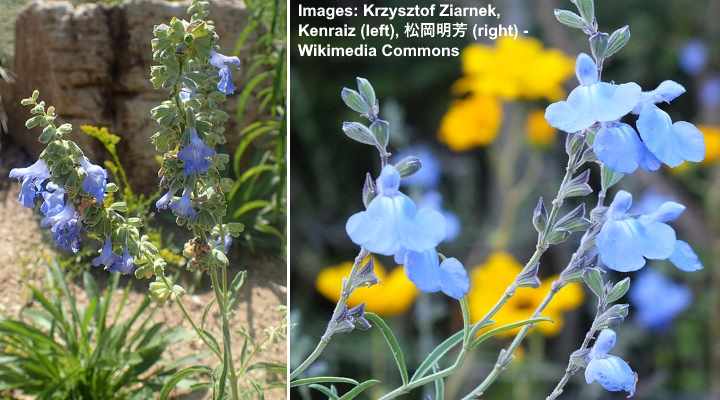
Pitcher Sage (Salvia azurea)
Anise-Scented Sage ‘Blue Enigma’ (Salvia guaranitica ‘Blue Enigma’): This tall perennial subshrub has rich royal blue-purple tubular flowers, small, ovate leaves that have anise aromas, and evergreen foliage. For USDA zones 8 to 10.
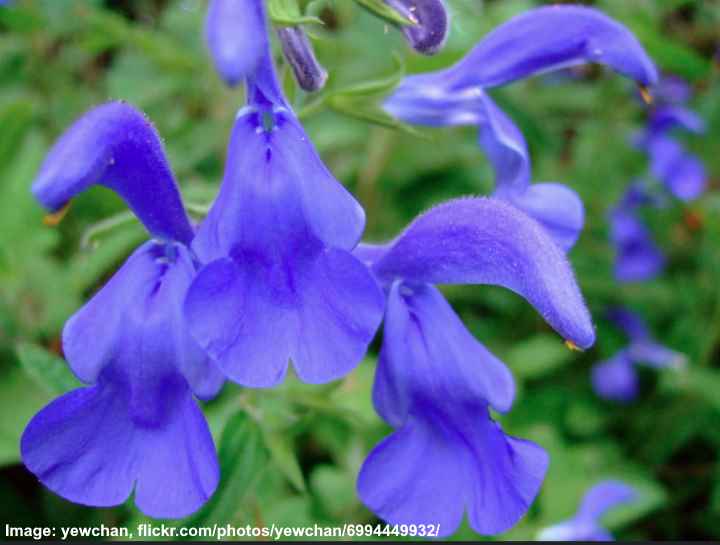
Anise-scented sage ‘Blue Enigma’ (Salvia guaranitica ‘Blue Enigma’)
Rosemary (Rosmarinus officinalis)

Rosemary is a versatile, shrubby evergreen herb known for its small, delicate light blue or dark purple-blue flowers and aromatic leaves. Thriving in full sun, rosemary shrubs are identified by their upright flowering woody stems, needle-like gray-green leaves, and small two-lipped tubular flowers.
Rosemary plants can grow up to 6 feet (1.8 m) tall and have a bushy, upright habit. Apart from being useful flowering shrubs for herb gardens, the woody aromas of rosemary leaves give stews, soups, and meat a distinct flavor. Rosemary is also commonly used as a low hedge or border plant in landscaping.
- Mature Size: 2 to 6 ft. (0.6 – 1.8 m)
- USDA Hardiness Zones: 8 to 11
- Sun Exposure: Full sun
- Soil Type: Well-drained, dry, sandy, or loamy soils
Cape Leadwort (Plumbago auriculata)
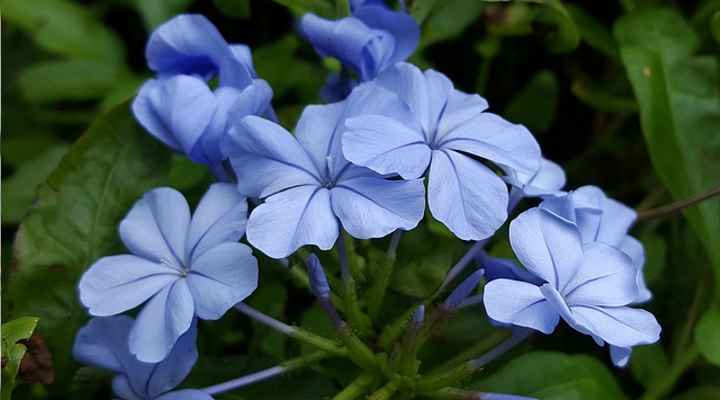
Cape leadwort is a beautiful mounding shrub with clusters of small, sky-blue flowers. The evergreen sprawling vine is identified by its five-lobed, funnel-shaped flowers, long-blooming season, and evergreen foliage on arching branches. Cape leadwort can grow up to 10 ft. (1.8 m) tall and has a spreading, vine-like habit.
Cape leadwort flowers attract butterflies and bees as they bloom continuously from spring until fall. The shrub’s spreading growth makes it ideal for evergreen ground cover, in borders, or as a vine on trellises and fences. The contrast of sky-blue hues and luscious evergreen foliage adds a touch of vibrant color to any garden or landscape.
- Mature Size: 6 to 10 ft. (1.8 – 3 m) tall and 8 to 10 ft. (2.4 – 3 m) wide
- USDA Hardiness Zones: 8 to 11
- Sun Exposure: Full sun to partial shade
- Soil Type: Organically rich, well-drained soils if protected from strong winds
Blue Potato Bush (Lycianthes rantonnetii)

Blue potato bush is a beautiful flowering shrub with deep purple-blue flowers. The fragrant deep blue cup-shaped flowers are easily recognizable and have bright golden yellow centers. These contrast nicely with the glossy green, ovate leaves. The fast-growing blue shrub is heat and drought-tolerant and suitable for deer-resistant gardens.
Blue potato bush shrubs can reach heights of up to 12 ft. (3.6 m) tall. You can also train the blue potato bush to scramble over a trellis or arbor. It also creates an attractive backdrop for a mixed flower bed to cover a fence or wall.
- Mature Size: 8 to 12 ft. (2.4 – 3.6 m) tall and 6 to 10 ft. (1.8 – 3 m) wide, or up to 15 ft. (4.5 m) as a scrambling climber
- USDA Hardiness Zones: 9 to 11
- Sun Exposure: Full sun
- Soil Type: Moist, well-drained soil
Blue Moon Wisteria (Wisteria macrostachya ‘Blue Moon’)

‘Blue Moon’ wisteria is a deciduous climbing shrubby vine with stunning cascades of lilac-blue flowers. The pea-like blue flowers bloom in June, forming conical clusters dangling from woody vines. Its dramatic light blue floral display transforms into pendulous, velvety bean like seed pods 5” (13 cm) long.
‘Blue Moon’ wisteria thrives in full sun and well-drained soil. It is a vigorous grower and requires sturdy support such as a trellis or pergola. This vine is a beautiful addition to gardens, arbors, and fences. Its long, hanging blue flower clusters create a dramatic and romantic display.
In the right conditions, ‘Blue Moon’ wisteria can bloom up to three times a season. Its stunning clusters of blue pea-like flowers measure 12” (30 cm) long.
- Mature Size: 15 to 25 ft. (4.5 – 7.6 m)
- USDA Hardiness Zones: 3 to 9
- Sun Exposure: Full sun
- Soil Type: Moderately fertile, well-drained soil with medium moisture
Blue Glorybower (Clerodendrum ugandense)

Also called blue butterfly bush, the blue-flowering shrub has blooms that resemble butterflies in flight. This tropical shrub has clusters of blue, pea-like flowers, heart-shaped green leaves with serrated edges, and black fleshy fruits in the fall. Thriving in full sun to partial shade, the blue shrub grows up to 10 ft. (3 m) tall.
Blue glorybower is ideal for a pop of relaxing blue shades to gardens, borders, and containers. In tropical gardens, it performs well as a blue-flowering ornamental shrub, foundation planting, or combined with other shrubs in mixed flower beds. You can also plant the shrub in rows to create a natural screen or privacy hedge.
- Mature Size: 6 to 10 ft. (1.8 – 3 m) tall and 2 to 3 ft. (0.6 – 1 m) wide
- USDA Hardiness Zones: 9 to 11
- Sun Exposure: Full sun or partial shade
- Soil Type: Moderately fertile, well-drained soil with plenty of organic matter
Blue Periwinkle ‘Giant Steps’ (Vinca major ‘Giant Steps’)

Blue periwinkle ‘Giant Steps’ is a purple-blue-flowering ground-hugging subshrub with long stems for growing in full sun or deep shade. The outstanding features of this blue shrub are its large, deep blue or violet-purple flowers 2” (5 cm) across, prostrate stems that root on the ground, and sea-green, sometimes variegated foliage.
Blue periwinkle grows less than 2 ft. (0.6 m) tall. Its vigorous growth quickly creates a dense mat of glossy green leaves contrasting with purple-blue flowers that bloom from spring to fall. Landscaping uses for blue periwinkle include blue-purple-flowering ground cover, hanging baskets, containers, or underplanting shrubs.
- Mature Size: 8” to 24” (20 – 60 cm) tall
- USDA Hardiness Zones: 7 to 9
- Sun Exposure: Full sun, partial shade, or complete shade
- Soil Type: Well-drained soils with dry to medium moisture
Blue-Flowering Clematis Shrubs (Clematis)
Blue-flowering clematis shrubs are vines that produce stunning tubular or funnel-shaped blue flowers. These climbing plants bloom in full sun from mid-summer through fall. Their woody stems produce purple-blue flowers and large, mid-green leaves. The beautiful shrubby vines are ideal for containers, scrambling up arbors or trellises, or mass planting.
Many clematis varieties have blooms in various shades of blue, ranging from pale sky blue to deep violet blue. Here are three blue-flowering clematis plants that are suitable for most landscapes:
Alpine Clematis (Clematis alpina)

Alpine clematis (Clematis alpina)
Alpine clematis is an early-blooming shrubby vine with nodding bell-shaped blue or mauve flowers. Identifying features of the plant are large, four-petalled deep blue flowers, palmate leaves with lance-shaped leaflets, and woody stems. They can grow up to 10 ft. (3 m) tall.
Blue-flowering alpine clematis shrubs are popular for adding vertical interest to gardens and landscapes. You can train the blue-flowering shrub to climb on walls, fences, or pergolas. Or it looks spectacular in containers or hanging baskets. Alpine clematis is also great for attracting pollinators like bees and butterflies to the garden.
- Mature Size: Up to 10 ft. (3 m) tall
- USDA Hardiness Zones: 3 to 9
- Sun Exposure: Partial shade to full shade
- Soil Type: Well-drained, fertile, acidic soil with abundant organic matter
Bush Clematis (Clematis integrifolia)
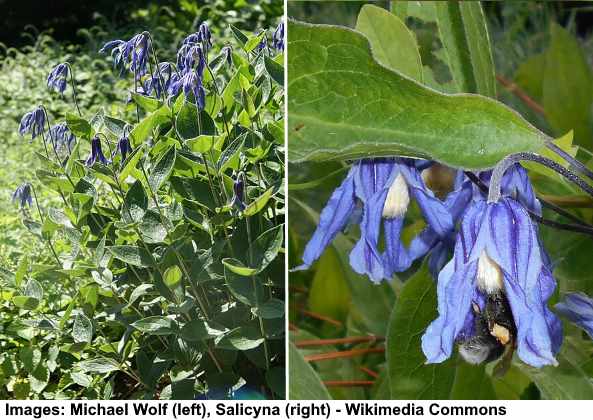
Bush clematis (Clematis integrifolia)
Also known as the solitary clematis, bush clematis is a small shrub with blue-lavender bell-shaped flowers nodding from arching stems. Blooming in spring and summer in full sun, the attractive, low-growing, clumping shrub or subshrub has lanceolate leaves, urn-shaped blue flowers, and silver-green seed pods in the fall.
Bush clematis typically grows up to 3 ft (1 m) tall, making it an ideal blue-flowering shrub for compact yards. This versatile shrub is ideal for planting in borders, containers, rock gardens, and cottage gardens. With its compact size and stunning blue flowers, bush clematis adds beauty and charm to any garden or landscape.
- Mature Size: 1.5 to 3 ft. (0.45 – 1 m) tall and wide
- USDA Hardiness Zones: 3 to 7
- Sun Exposure: Full sun to partial shade
- Soil Type: Well-drained, fertile, acidic soil that retains moisture
Tube Clematis (Clematis heracleifolia)

Tube clematis (Clematis heracleifolia)
Tube clematis is a deciduous subshrub with mauve bell-shaped flowers that bloom throughout summer until fall. This perennial subshrub features trifoliate leaves, beautiful blue flowers with recurved petals, and ornamental silky seed heads. This non-climbing blue-flowering bushy plant grows up to 3 ft. (1 m) tall.
Tube clematis shrubs prefer full sun to partial shade and well-drained soil. It is a good addition to a sunny perennial border, growing as a scrambling bush or used to decorate a patio container.
- Mature Size: 2 to 3 ft. (0.6 – 1 m) tall and wide
- USDA Hardiness Zones: 4 to 8
- Sun Exposure: Full sun
- Soil Type: Well-drained, acidic soil with plenty of organic matter
Purple Gromwell ‘Grace Ward’ (Lithodora diffusa ‘Grace Ward’)
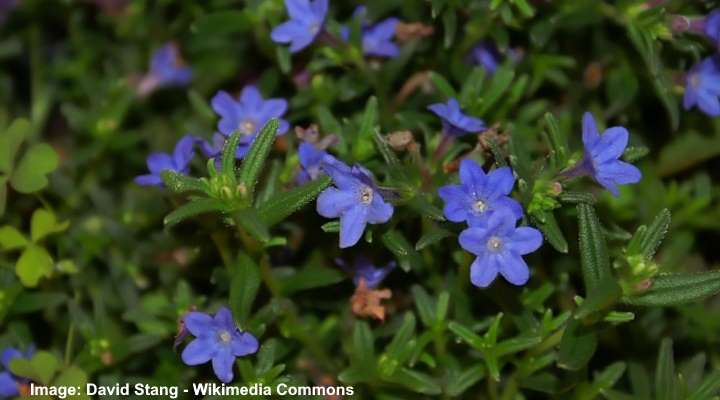
Purple gromwell ‘Grace Ward’ is a low-growing perennial shrub with vibrant blue flowers, trailing stems, and evergreen foliage. This mat-forming shrubby plant is identified by its deep blue, star-shaped flowers, hairy, lanceolate leaves, and spreading nature. The sprawling shrub spreads up to 3 ft. (1 m) wide but grows less than a foot (30 cm) tall.
The ornamental feature of this hardy perennial is its dense clusters of small trumpet-shaped blue blooms. You can plant the heat-tolerant shrub as ground cover in full sun, border plants, or for coastal gardens. You can also grow it in containers or hanging baskets.
- Mature Size: 6” to 12” (15 – 30 cm) tall and 24” to 36” (60 – 90 cm) wide
- USDA Hardiness Zones: 6 to 8
- Sun Exposure: Full sun to partial shade
- Soil Type: Well-drained, acidic soils
Golden Dewdrops (Duranta erecta)

Golden dewdrops is a tropical blue-purple flowering evergreen shrub that thrives in full sun. The attractive landscaping shrub is identified by its violet-blue blossoms on arching, vine-like stems, rich green leaves, and clusters of golden yellow berries. Although it’s a spreading plant, you can grow it as a rounded shrub.
Golden dewdrops shrubs grow up to 20 ft. (6 m) tall and 10 ft. (3 m) wide. Thriving in light shade, they perform best as evergreen tropical hedges, border shrubs, or container plants. In colder climates, you can grow golden dewdrops as an annual or in a container to overwinter indoors.
- Mature Size: 10 to 20 ft. (3 – 6 m) tall and 6 to 10 ft. (1.8 – 3 m) wide in tropical climates
- USDA Hardiness Zones: 10 and 11
- Sun Exposure: Full sun
- Soil Type: Well-drained, moist, acidic soils
Butterfly Bush Shrubs (Buddleja davidii)
Butterfly bush shrubs are popular flowering shrubs with purple or blue flowers. The shrubs are characterized by long, arching branches, lanceolate gray-green leaves, and conical clusters of bluish-purple, fragrant flowers. The long-blooming, blue-flowering shrubs attract butterflies to the front and backyards.
Butterfly bush shrubs are low-maintenance and easy-to-grow blue-flowering plants. They prefer full sun but can tolerate some shade. These shrubs thrive in well-drained soil and are drought-tolerant once established. They are commonly used in borders, hedges, and as focal points in gardens. Pruning in early spring helps promote new growth and a more compact shape.
Here are two varieties of butterfly bush shrubs that have blue-purple flowers:
Buddleja davidii ‘Adonis Blue’

‘Adonis Blue’ butterfly bush
Buddleja davidii ‘Adonis Blue’ is a dwarf blue-flowering shrub with cone-shaped flower clusters of dark blue-purple flowers. This attractive low-growing shrub blooms from June through September. It’s popular for foundation planting, cottage gardens, borders, or butterfly gardens. Its compact growth makes it perfect for small garden landscapes.
- Mature Size: 3 to 5 ft. (1 – 1.5 m) tall wide
- USDA Hardiness Zones: 5 to 9
- Sun Exposure: Full sun
- Soil Type: Well-drained soils with medium moisture
Buddleja davidii ‘Dart’s Papillon Blue’
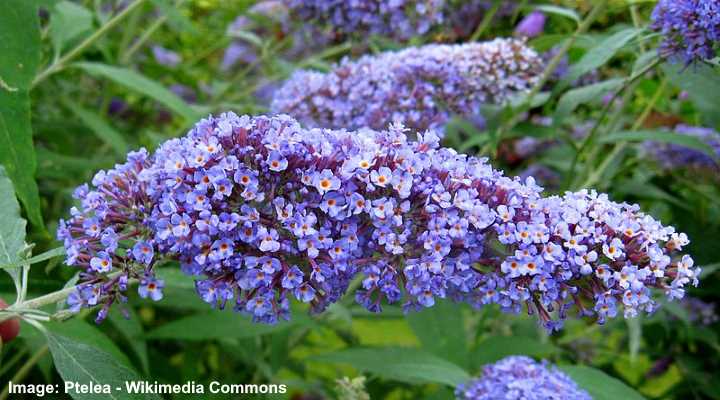
‘Dart’s Papillon Blue’ butterfly bush
Buddleja davidii ‘Dart’s Papillon Blue’ is a beautiful shrub with creamy pale blue-purple flowers. Like most butterfly bushes, the flower clusters are conical panicles of small, fragrant flowers. The spike-like, sweetly scented blue-purple flowers contrast with the sage-green lanceolate leaves. The long-blooming shrub has purple-blue flowers from summer to fall.
The flowers are highly attractive to butterflies and other pollinators. This shrub can grow up to 7 ft. (2.1 m) tall and wide. It’s a great addition to gardens, shrub borders, butterfly gardens, and planting along a foundation line.
- Mature Size: 6 to 7 ft. (1.8 – 2.1 m) tall wide
- USDA Hardiness Zones: 5 to 9
- Sun Exposure: Full sun
- Soil Type: Medium moisture, well-drained soils
Related articles:
